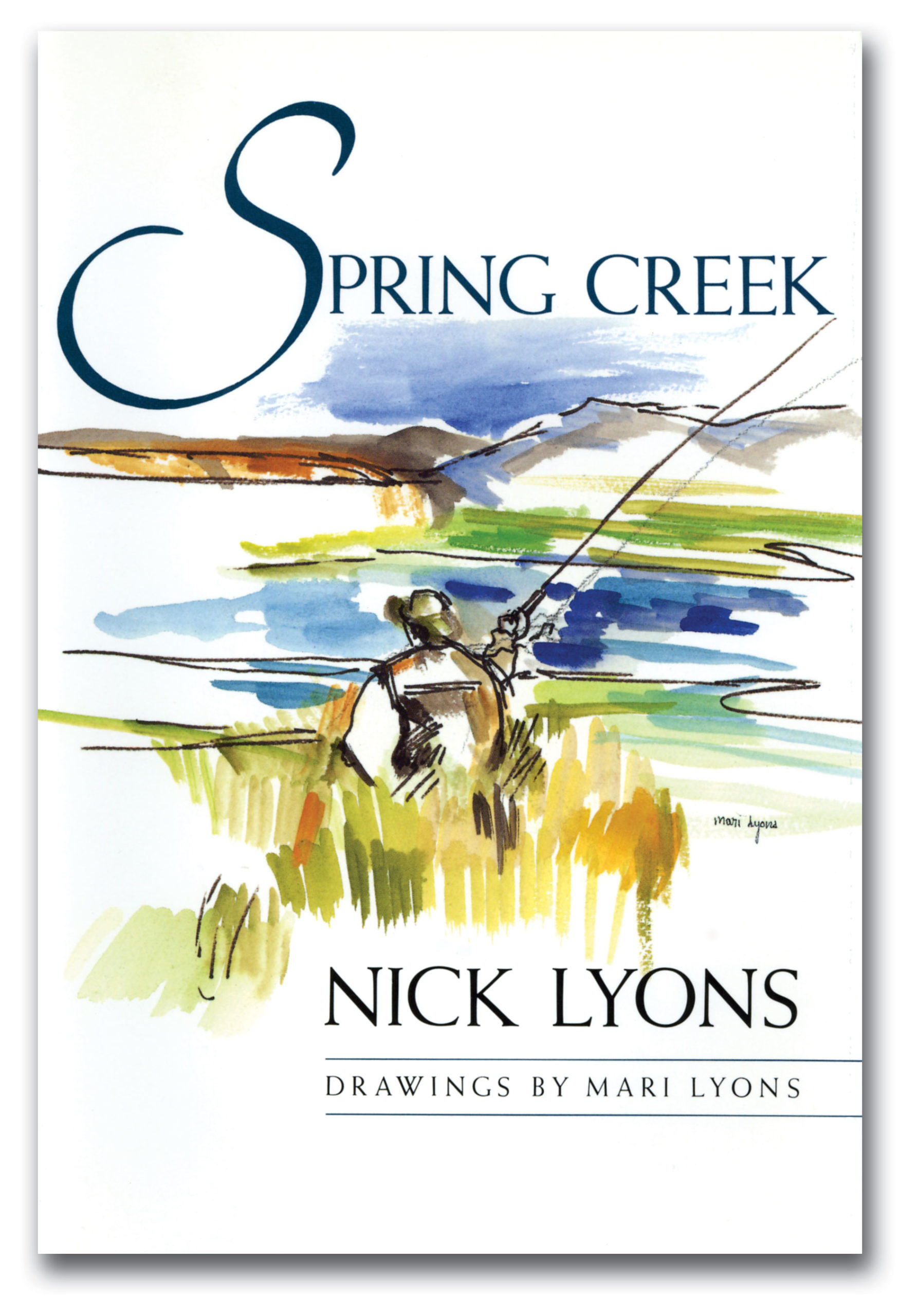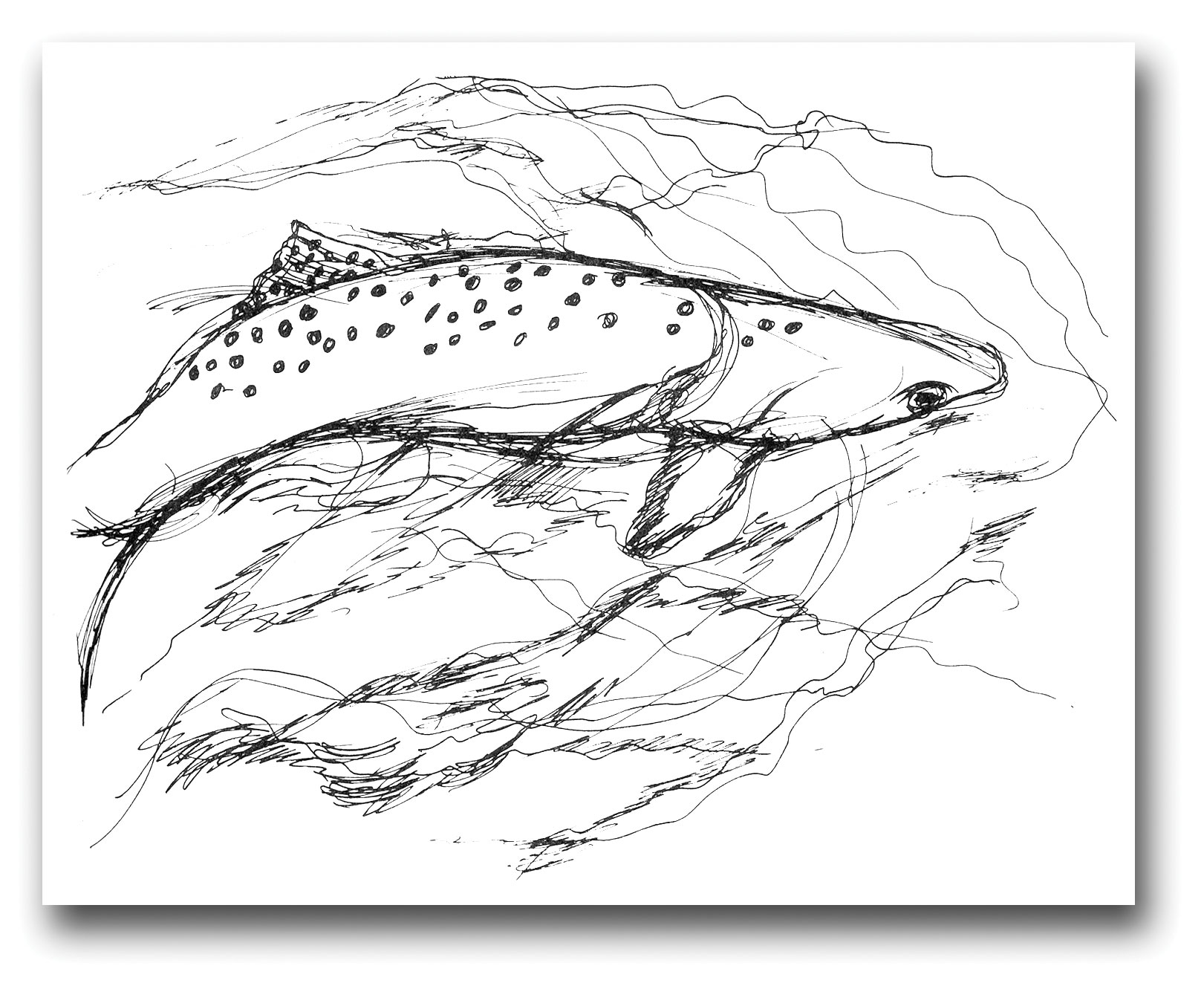2022 marks the thirtieth anniversary of the publication of Spring Creek by Nick Lyons. In the Spring 2012 (Vol. 38, No. 2) issue of the American Fly Fisher, we ran an article by Dennis LaBare celebrating the then-twentieth anniversary of Lyons’s book, and felt it only fitting to share it once again to honor this beloved classic of angling literature.
Twenty Years of Spring Creek
By Dennis LaBare
Fly Fisherman magazine began publishing in 1969, but it was seven more years before soon-to-be New York fly-fishing publisher Nick Lyons assumed the helm of a column found at the end of each issue. For twenty-three years, Nick offered his experiences, both piscatorial and philosophical, to anglers who read to the very end of each issue or to nuts like me who started at the back. “The Seasonable Angler” drew on the thoughtful side of the quiet sport. Nick remained faithful to this regular assignment from the 1976 Spring Special issue through the December 1998 issue. If you’re a Fly Fisherman reader, you’ll notice that the column title stuck, even after he’d moved on.
Nick also began a solid book-writing, editing, and publishing career. With a doctorate in English from the University of Michigan, he taught at both Michigan and Hunter College and maintained a faculty position at Hunter through 1988. But the publishing bug had bitten, and in 1977, leveraging his executive editorship at Crown Publishers, he created Nick Lyons Books. The thoughtful, introspective side of Nick didn’t let his executive obligations keep him from his own writing, and he continued to produce exquisite prose.
Which brings us to 1992 and the publication of his wonderful book, Spring Creek, beautifully illustrated by his artist wife, Mari. This year [2012] marks the twentieth anniversary of its release.
A small, artful work, it caught the attention of this angler more than anything else Nick had written. Spring Creek is about spending more than a month on a large spring creek, fishing every day—no crowds or other distractions—with its owner, who knew it intimately. Was this perfection or what?
When I first ventured to Letort Spring Run in August 1969, not far from my then-suburban Baltimore home—even meeting Vince Marinaro on his property that day—I was embarking on a fly-fishing journey of my own. The next year, my lifelong angling friend Bruce Craddock took me to the famed Falling Spring Branch. It was Bruce who loaned me Spring Creek, soon after its publication, and after a quick read, the jewel was filed in my mind permanently.

For years, we wondered about the name and location of “Spring Creek,” its identity hidden within Nick’s enchanting prose. We were both born-and-raised spring-creek fishermen—how could we find and fish this place? As the busy years passed, Bruce and I would ruminate again and again on the idea of finding and fishing Spring Creek. As our maturation in the community of fly fishing grew, we felt we might somehow be getting closer—maybe we’d meet that key person, perhaps get a lucky break. The years continued to slip by.
At Bruce’s continual urging, I began an initiative for the conservation of our beloved Falling Spring Branch twenty-some years after he introduced me to it. The project and I (as its point man) became nationally known for our accomplishments on this famous spring creek. I dreamed that this might result in an insider calling me one day and inviting me to fish Spring Creek. I envisioned Bruce and myself heading out together, triumphantly, to fish this seemingly mythical place. No such luck. Spring Creek, as we would eventually learn, flowed within the confines of two enormous western ranches—very private ranches—owned by substantial, discreet people who, you could say, weren’t looking for any uninvited company. “Closely held” might describe it best.
During the development of Falling Spring Greenway, I had asked certain of fly angling’s biggest personalities to lend their names to an honorary/advisory board to help build our credibility and fund-raising ability—you know, the prominent, accomplished folks listed in the left margin of the letterhead that we’d send out begging for money. Conversations with some of them about Spring Creek produced only vague references; some expressed the wistful desire to go there themselves. The mystery deepened. Busy with life, Spring Creek slipped further back on the clipboard but never went away.
As we read Spring Creek back then, we could readily identify with the environment and with the challenges of fishing such water. In fact, it was completely familiar to us, though it was obviously new and challenging to Nick: ultraclear water; long, delicate leaders; impossibly spooky and selective trout; and, of course, laser-accurate casting. Nick, while not a novice fly angler by any stretch, had to adapt to these demands, and adapt he did. Spring Creek was that kind of place, basically: adapt or go home.

Renowned artist Mari Lyons (1935-2016) often accompanied her husband Nick on his fishing travels across the country. Inspired by the landscapes she encountered and the fluid grace of fly fishing, Mari produced hundreds of sketches over the course of several years. Many of these, including the above image, can be found in Spring Creek.
But besides this adaptation, Nick got something else, something we missed. He got to consciously observe himself, and he conveyed to us in fine style his evolution as a fly angler. For just as had happened unconsciously to both Bruce and me when we were teenagers, there was a force working upon Nick on Spring Creek. It is a force that slows you, directing you to a more deliberative, observationally intense way of angling. As kids, we didn’t realize this was happening to us. In retrospect, we might have appreciated noticing. Nick, as a perceptive adult, recognized what was happening to him, slowly but surely, as he fished. He thought about and absorbed the lessons of Spring Creek and its wild trout, as well as those of his friend Herb, Spring Creek’s owner. Bruce and I never enjoyed this satisfaction. Our skills were developed in the crucible of command performance, something youth and blissful ignorance could not resist.
Even in the selection of his tackle, Nick was evolving. The lovely, easy action of his favored cane rod, at Herb’s urging, gave way to graphite with substantial backbone. The winds he described on that open landscape were a challenge for him; for Bruce and me, narrow corridors of overhanging vegetation, floating weed beds, and complex crosscurrents inviting drag were our curses. Line control and accuracy were king, and so the tools had to change.
When Bruce and I finally had our chance to fish Spring Creek, it did not come by way of the romantic notions with which we’d amused ourselves; perhaps that was the fairness of reality. It came through the ordinary avenue of a western fly shop that, amazingly, offered very limited days on Spring Creek. It did not matter. The owners, for their own reasons, and as it should be, opened Spring Creek to the public, if ever so briefly, and we as the public, for a price, could sample its delights. We jumped at the chance. Finally, a dream come true.
Because Nick was graciously one of the willing who served on our Falling Spring Greenway Honorary/Advisory Board, I called him to exalt in our good fortune. He shared our enthusiasm, sending some of his flies and even a small, hand-sketched map on his personal stationery. We returned the flies; we kept the map as a treasure. Even the contents of Nick’s fly box told of his evolution and immersion into the realm of highly selective trout. No more Parachute Adams or Humpys, as he described in his early experiences. What he sent were flies intended to directly imitate naturals hatching on Spring Creek or, in the case of terrestrials, falling into it. We caught fish on his flies
. It sweetened the moment, and it felt like Nick was with us in spirit.
I vividly recall bumping along the ranch road just as Nick did with his friend Herb in the tan Suburban. When Bruce and I arrived at the “bluff that ended the last bench” (page 4), we got out of the truck and were nothing short of awestruck as we gazed south over the gloriously vast, open valley and Spring Creek. Stretched out enticingly before us in all its sinuous, weedy, silken-current splendor to the virtual horizon, Spring Creek was finally ours—for two days. It was an epiphany for Bruce and me: walking in Nick’s footsteps; being in a place Fly Fisherman editor John Randolph had told me was “the best spring creek on earth”; catching large, handsome, perfectly formed brown trout in the same pools about which Nick wrote, with not another soul in sight and the beauty of the western Rockies all around us. It was all there, just as Nick told us, lo, those many years ago.
But Spring Creek, fortunately, was not ours or anyone else’s for those two days, or for any amount of time we might have been so lucky to have spent there. It belongs, in a larger sense, and because of Nick, to all of us for the ages, for the romance and reality of Spring Creek can be experienced by everyone in those lovely 169 pages. I’ve dubbed Nick the High Priest of the Spring Creek Culture; Bruce and I are mere disciples. If you count yourself among us, you know who you are. Thanks, Nick! Long may you reign!

